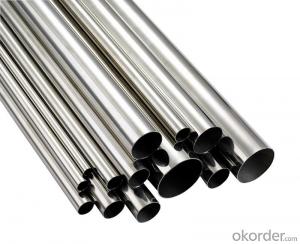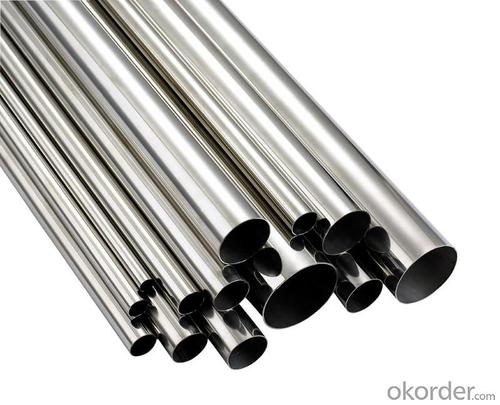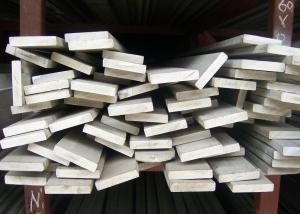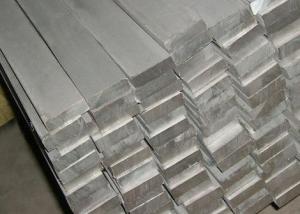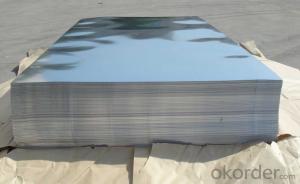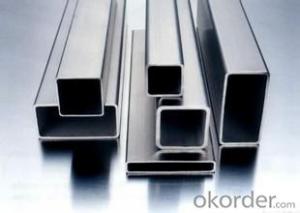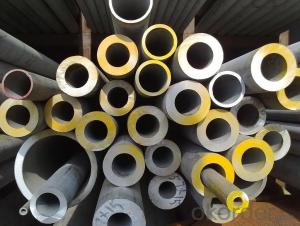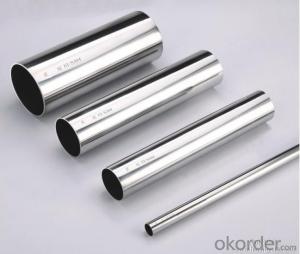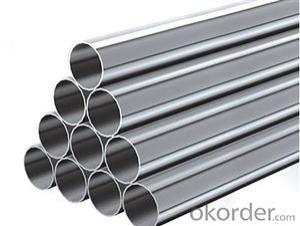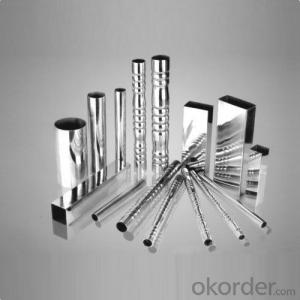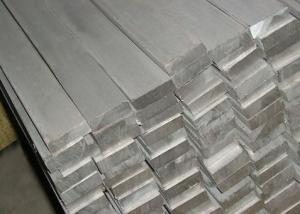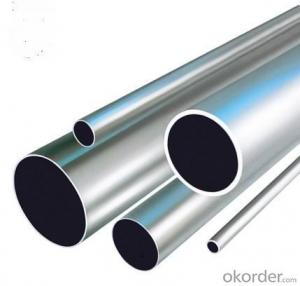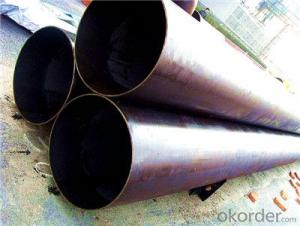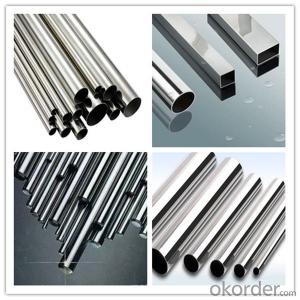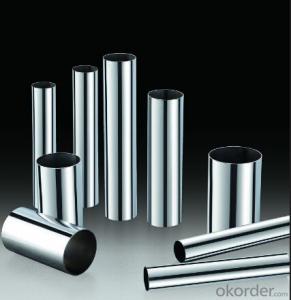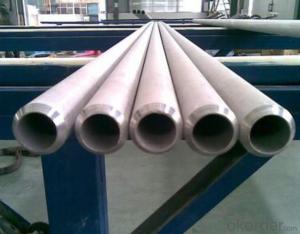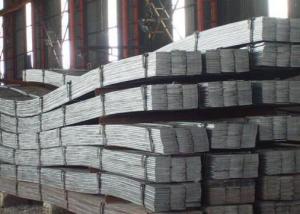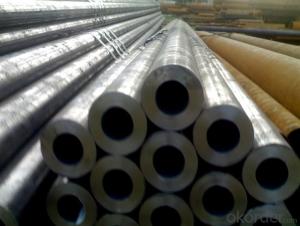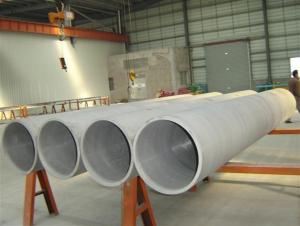STAINLESS STEEL PIPES 201 pipe low price
- Loading Port:
- China Main Port
- Payment Terms:
- TT OR LC
- Min Order Qty:
- -
- Supply Capability:
- -
OKorder Service Pledge
OKorder Financial Service
You Might Also Like
Description:
Stainless Steel Pipe
Material:
304 321 316 310
Packing:
In bundle
MOQ:
5 TONS
Comparison of standardized steels
| EN-standard Steel no. k.h.s DIN | EN-standard Steel name | SAE grade | UNS |
|---|---|---|---|
| 1.4109 | X65CrMo14 | 440A | S44002 |
| 1.4112 | X90CrMoV18 | 440B | S44003 |
| 1.4125 | X105CrMo17 | 440C | S44004 |
| | | 440F | S44020 |
| 1.4016 | X6Cr17 | 430 | S43000 |
| 1.4408 | G-X 6 CrNiMo 18-10 | 316 | |
| 1.4512 | X6CrTi12 | 409 | S40900 |
| | | 410 | S41000 |
| 1.4310 | X10CrNi18-8 | 301 | S30100 |
| 1.4318 | X2CrNiN18-7 | 301LN | |
| 1.4307 | X2CrNi18-9 | 304L | S30403 |
| 1.4306 | X2CrNi19-11 | 304L | S30403 |
| 1.4311 | X2CrNiN18-10 | 304LN | S30453 |
| 1.4301 | X5CrNi18-10 | 304 | S30400 |
| 1.4948 | X6CrNi18-11 | 304H | S30409 |
| 1.4303 | X5CrNi18-12 | 305 | S30500 |
| | X5CrNi30-9 | 312 | |
| 1.4541 | X6CrNiTi18-10 | 321 | S32100 |
| 1.4878 | X12CrNiTi18-9 | 321H | S32109 |
| 1.4404 | X2CrNiMo17-12-2 | 316L | S31603 |
| 1.4401 | X5CrNiMo17-12-2 | 316 | S31600 |
| 1.4406 | X2CrNiMoN17-12-2 | 316LN | S31653 |
| 1.4432 | X2CrNiMo17-12-3 | 316L | S31603 |
| 1.4435 | X2CrNiMo18-14-3 | 316L | S31603 |
| 1.4436 | X3CrNiMo17-13-3 | 316 | S31600 |
| 1.4571 | X6CrNiMoTi17-12-2 | 316Ti | S31635 |
| 1.4429 | X2CrNiMoN17-13-3 | 316LN | S31653 |
| 1.4438 | X2CrNiMo18-15-4 | 317L | S31703 |
| 1.4362 | X2CrNi23-4 | 2304 | S32304 |
| 1.4462 | X2CrNiMoN22-5-3 | 2205 | S31803/S32205 |
| 1.4539 | X1NiCrMoCu25-20-5 | 904L | N08904 |
| 1.4529 | X1NiCrMoCuN25-20-7 | | N08926 |
| 1.4547 | X1CrNiMoCuN20-18-7 | 254SMO | S31254 |
Stainless steel’s resistance to corrosion and staining, low maintenance and familiar lustre make it an ideal material for many applications. There are over 150 grades of stainless steel, of which fifteen are most commonly used. The alloy is milled into coils, sheets, plates, bars, wire, and tubing to be used in cookware, cutlery, household hardware, surgical instruments, major appliances, industrial equipment (for example, in sugar refineries) and as an automotive and aerospace structural alloy and construction material in large buildings. Storage tanks and tankers used to transport orange juice and other food are often made of stainless steel, because of its corrosion resistance. This also influences its use in commercial kitchens and food processing plants, as it can be steam-cleaned and sterilized and does not need paint or other surface finishes.
Stainless steel is used for jewelry and watches with 316L being the type commonly used for such applications. It can be re-finished by any jeweler and will not oxidize or turn black.
Some firearms incorporate stainless steel components as an alternative to blued or parkerized steel. Some handgun models, such as the Smith & Wesson Model 60 and the Colt M1911 pistol, can be made entirely from stainless steel. This gives a high-luster finish similar in appearance to nickel plating. Unlike plating, the finish is not subject to flaking, peeling, wear-off from rubbing (as when repeatedly removed from a holster), or rust when scratched.
Architecture[edit]
Stainless steel is used for buildings for both practical and aesthetic reasons. Stainless steel was in vogue during the art deco period. The most famous example of this is the upper portion of the Chrysler Building (pictured). Some diners and fast-food restaurants use large ornamental panels and stainless fixtures and furniture. Because of the durability of the material, many of these buildings retain their original appearance.
Type 316 stainless is used on the exterior of both the Petronas Twin Towers and the Jin Mao Building, two of the world's tallest skyscrapers.[17]
The Parliament House of Australia in Canberra has a stainless steel flagpole weighing over 220 tonnes (240 short tons).
The aeration building in the Edmonton Composting Facility, the size of 14 hockey rinks, is the largest stainless steel building in North America.
Bridges[edit]
Cala Galdana Bridge in Minorca (Spain) was the first stainless steel road bridge.
Sant Fruitos Pedestrian Bridge (Catalonia, Spain), arch pedestrian bridge.
Padre Arrupe Bridge (Bilbao, Spain) links the Guggenheim museum to the University of Deusto.[18]
Monuments and sculptures[edit]
The Unisphere, constructed as the theme symbol of the 1964-5 World's Fair in New York City, is constructed of Type 304L stainless steel as a sphere with a diameter of 120 feet, or 36.57 meters.
The Gateway Arch (pictured) is clad entirely in stainless steel: 886 tons (804 metric tonnes) of 0.25 in (6.4 mm) plate, #3 finish, type 304 stainless steel.[19]
The United States Air Force Memorial has an austenitic stainless steel structural skin.
The Atomium in Brussels, Belgium was renovated with stainless-steel cladding in a renovation completed in 2006; previously the spheres and tubes of the structure were clad in aluminium.
The Cloud Gate sculpture by Anish Kapoor, in Chicago US.
The Sibelius monument in Helsinki, Finland, is made entirely of stainless steel tubes.
The Man of Steel (sculpture) under construction in Rotherham, England.
Other[edit]
- Automotive bodies
The Allegheny Ludlum Corporation worked with Ford on various concept cars with stainless steel bodies from the 1930s through the 1970s, as demonstrations of the material's potential. The 1957 and 1958 Cadillac Eldorado Brougham had a stainless steel roof. In 1981 and 1982, the DeLorean DMC-12 production automobile used stainless steel body panels over a glass-reinforced plasticmonocoque. Intercity buses made by Motor Coach Industries are partially made of stainless steel. The aft body panel of the Porsche Cayman model (2-door coupe hatchback) is made of stainless steel. It was discovered during early body prototyping that conventional steel could not be formed without cracking (due to the many curves and angles in that automobile). Thus, Porsche was forced to use stainless steel on the Cayman.
- Passenger rail cars
Rail cars have commonly been manufactured using corrugated stainless steel panels (for additional structural strength). This was particularly popular during the 1960s and 1970s, but has since declined. One notable example was the early Pioneer Zephyr. Notable former manufacturers of stainless steel rolling stock included the Budd Company (USA), which has been licensed to Japan's Tokyu Car Corporation, and the Portuguese company Sorefame. Many railcars in the United States are still manufactured with stainless steel, unlike other countries who have shifted away.
- Aircraft
Budd also built an airplane, the Budd BB-1 Pioneer, of stainless steel tube and sheet, which is on display at the Franklin Institute.
The American Fleetwings Sea Birdamphibious aircraft of 1936 was also built using a spot-welded stainless steel hull.
The Bristol Aeroplane Company built the all-stainless steel Bristol 188 high-speed research aircraft, which first flew in 1963.
The use of stainless steel in mainstream aircraft is hindered by its excessive weight compared to other materials, such as aluminum.
- Jewelry
Valadium, a stainless steel and 12% nickel alloy is used to make class and military rings. Valadium is usually silver-toned, but can be electro-charged to give it a gold tone. The gold tone variety is known as Sun-lite Valadium
- Q: Can stainless steel pipes be used for sewage systems?
- Yes, stainless steel pipes can be used for sewage systems. Stainless steel is highly resistant to corrosion and can withstand the harsh conditions and chemicals found in sewage. It also has a smooth surface, which helps prevent the buildup of waste and reduces the risk of clogging. Additionally, stainless steel pipes are durable and long-lasting, making them a reliable choice for sewage systems.
- Q: How do stainless steel pipes compare to PVC pipes?
- Stainless steel pipes and PVC pipes are utilized extensively in various industries and applications, but they possess distinct dissimilarities that render them suitable for different purposes. A crucial disparity lies in their material composition. Stainless steel pipes are crafted from an amalgamation of iron, chromium, and other elements, affording them exceptional strength and resistance to corrosion. Conversely, PVC pipes are constructed from a synthetic plastic polymer called polyvinyl chloride, which provides good chemical resistance but lacks the strength of stainless steel. Concerning strength and durability, stainless steel pipes hold the advantage. They can endure high pressure and exhibit remarkable heat resistance, rendering them ideal for tasks involving the conveyance of hot liquids or gases. PVC pipes, although less robust, are lightweight and flexible, making them easier to manipulate and install in specific applications. Another vital aspect to consider is cost. PVC pipes generally boast a more affordable price compared to stainless steel pipes, hence their popularity in residential plumbing and low-pressure applications. Stainless steel pipes, due to their higher expense, find more usage in industrial settings where superior strength and resistance to corrosion are imperative. In terms of lifespan, stainless steel pipes enjoy a lengthier expectancy compared to PVC pipes. Stainless steel demonstrates high resistance to corrosion, rust, and other chemical reactions, enabling it to maintain its structural integrity over a longer duration. PVC pipes, while durable, can deteriorate over time due to exposure to UV light, extreme temperatures, and certain chemicals. Concerns surrounding environmental impact have been raised regarding PVC pipes over the years due to the production and disposal processes, which involve the release of toxic chemicals. In contrast, stainless steel pipes are deemed more environmentally friendly as they can be recycled and possess a lengthier lifespan. In conclusion, stainless steel pipes and PVC pipes possess their own unique characteristics and benefits. Stainless steel pipes excel in strength, durability, and resistance to corrosion, making them suitable for high-pressure and high-temperature applications. PVC pipes, in contrast, are lightweight, cost-effective, and easy to install, making them a popular choice for low-pressure applications. Ultimately, the selection between these two materials hinges on the specific requirements and limitations of the project at hand.
- Q: What is the maximum temperature stainless steel pipes can withstand?
- The maximum temperature that stainless steel pipes can withstand depends on the specific grade of stainless steel used. Generally, stainless steel pipes can withstand high temperatures ranging from 1200°C to 1400°C (2200°F to 2550°F). However, it is important to note that the exact maximum temperature may vary based on factors such as the composition of the stainless steel, the duration of exposure to high temperatures, and the presence of any corrosive elements in the environment. It is always recommended to consult the manufacturer's specifications or a professional engineer for specific temperature limits for a particular grade of stainless steel pipe.
- Q: Are stainless steel pipes suitable for pharmaceutical applications?
- Yes, stainless steel pipes are highly suitable for pharmaceutical applications. Stainless steel is a corrosion-resistant material that meets the strict hygiene and cleanliness requirements of the pharmaceutical industry. It is non-reactive, easy to clean, and has excellent resistance to chemicals, making it ideal for transporting pharmaceutical products safely and maintaining their integrity. Additionally, stainless steel pipes can withstand high temperatures and pressures, ensuring the efficiency and reliability of pharmaceutical processes.
- Q: What is the maximum length of a stainless steel pipe that can be manufactured?
- Practical limitations, including transportation and handling capabilities, typically dictate the maximum length achievable for stainless steel pipes. Generally, these pipes can vary in length from a few feet to several hundred feet. Nevertheless, the precise maximum length is subject to change based on factors like pipe diameter, thickness, and the manufacturing capabilities of the company or facility involved. To ascertain the specific maximum length of a stainless steel pipe, consultation with the manufacturer or supplier is crucial.
- Q: Can stainless steel pipes be used for compressed air systems?
- Yes, stainless steel pipes can be used for compressed air systems. Stainless steel is highly resistant to corrosion and can withstand high pressure, making it a suitable material for handling compressed air.
- Q: Can stainless steel pipes be used for food storage facilities?
- Yes, stainless steel pipes can be used for food storage facilities. Stainless steel is a preferred material for food storage and processing due to its durability, corrosion resistance, and hygienic properties. It does not react with food or release any harmful substances, making it safe for storing various types of food products. Stainless steel pipes are also easy to clean and maintain, ensuring the highest levels of hygiene in food storage facilities. Additionally, stainless steel is resistant to high temperatures, making it suitable for both hot and cold food storage. Overall, stainless steel pipes are an excellent choice for food storage facilities due to their safety, durability, and hygienic properties.
- Q: What is the difference between Schedule 5 and Schedule 10 stainless steel pipes?
- Schedule 5 and Schedule 10 stainless steel pipes are both commonly used in various industries and applications, but there are some key differences between the two. The main difference lies in their wall thickness. Schedule 5 stainless steel pipes have a thinner wall thickness compared to Schedule 10 stainless steel pipes. This means that Schedule 5 pipes have a higher internal diameter, allowing for a greater flow of fluids or gases through the pipe. Schedule 10 stainless steel pipes, on the other hand, have a thicker wall thickness, resulting in a smaller internal diameter. This makes them more suitable for applications that require higher pressure or strength, as the thicker walls provide increased durability and resistance to external forces. Additionally, the different wall thicknesses of Schedule 5 and Schedule 10 pipes affect their weight and cost. Due to the thinner walls, Schedule 5 pipes are lighter and less expensive than Schedule 10 pipes. In terms of availability, Schedule 10 stainless steel pipes are more commonly used in industrial processes that involve high pressure or corrosive environments, such as chemical plants or oil refineries. Schedule 5 stainless steel pipes are often used in applications where the flow of fluids or gases is not under extreme pressure, such as plumbing or low-pressure conveying systems. In summary, the main differences between Schedule 5 and Schedule 10 stainless steel pipes lie in their wall thickness, internal diameter, strength, weight, and cost. The choice between the two depends on the specific requirements of the application and the level of pressure or durability needed.
- Q: What kind of welding machine is used for welding thin stainless steel plate and stainless steel square tube?
- 1 mm thick enough, basically argon arc welding machine can, 0.2 thick stainless steel plate welding is not good ah, how have three or four points it can be positive or negative, only a few joints only, mainly to see the technology myself you, not what, the polishing wheel is on the line let's do it, you can buy a good quality of argon arc welding machine, the high price of the arc is stable
- Q: How are stainless steel pipes different from carbon steel pipes?
- Stainless steel pipes are different from carbon steel pipes in terms of their composition and properties. Stainless steel pipes contain a higher percentage of chromium, which forms a protective layer on the surface, making them resistant to corrosion and rust. On the other hand, carbon steel pipes do not have this protective layer and are susceptible to corrosion. Stainless steel pipes are also more durable and have higher tensile strength compared to carbon steel pipes.
Send your message to us
STAINLESS STEEL PIPES 201 pipe low price
- Loading Port:
- China Main Port
- Payment Terms:
- TT OR LC
- Min Order Qty:
- -
- Supply Capability:
- -
OKorder Service Pledge
OKorder Financial Service
Similar products
Hot products
Hot Searches
Related keywords
